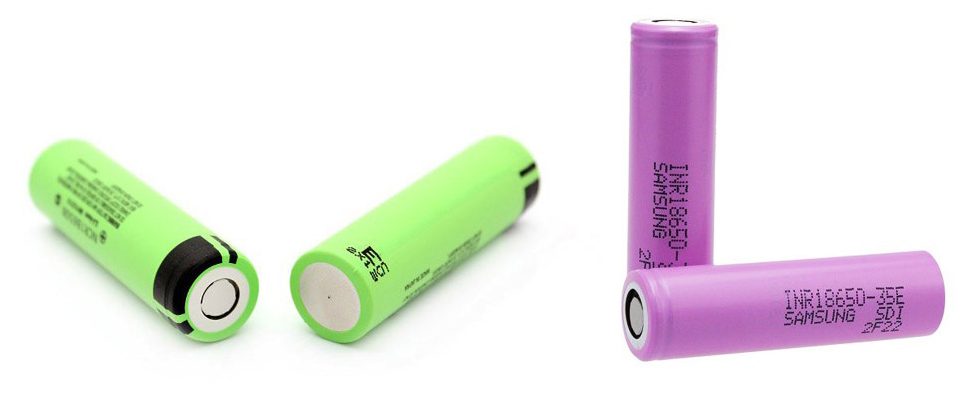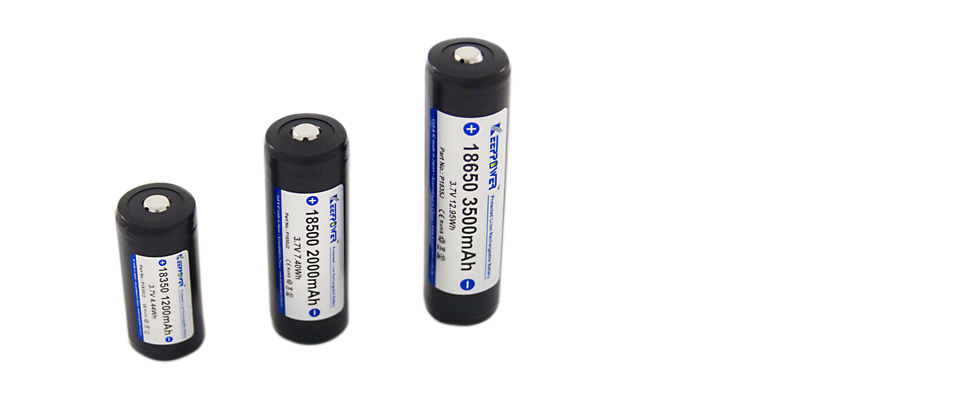Batteries for the 21st century
This is currently the best power source for modern powerful LED headlamps and there is no reason to use any other type of battery today. They are used by NASA in satellites, by car companies in electric cars for their clear advantages - high capacity, low weight, reliability.
Li-ion batteries have the best ratio between capacity and weight (volume). They are tested by industrial use and are safe. The cells are lightweight and store a large amount of energy. They are manufactured rechargeable only, so they do not pollute the environment like disposable batteries. They will last you for many years without complications and if you take care of them in the right way, you will not even experience any drop in capacity over the years. They are really reliable, if you charge them they will always deliver energy.
Li-ion (Lithium-Ion) batteries are almost exclusively cylindrical (cylindrical) batteries with a charging voltage of 4.2V and a lifetime of 500-1500 full cycles. There are different sizes, but the most widely used type is the 18650 size, a cylindrical cell with a diameter of 18mm and a length of 65mm. More recently electric cars pull forward the 21700 type.

Technical parameters of current 18650 batteries
All standard Li-ion batteries are charged by the CC/CV algorithm to a final voltage of 4.2V. The average, nominal voltage, is 3.6V (or 3.7V). Batteries can usually be discharged down to 2.5V, previously they only went to 2.8V. Lower voltage is dangerous, you can destroy the cell. The internal resistance ranges from 20 to 80 milliohms depending on the brand and type (low or high current).
Thehighest current capacity is about 3450mAh with a stored energy of no more than 12.4Wh. At higher draws, the stored energy (and capacity) decreases a bit.
The battery usually allows a max current draw (Max. Discharge Continuous Current) of 3-10A, high current batteries used in tools up to 30A.
The battery will provide 500-1000 full cycles before the capacity drops to 70-80% of the original value. Life can be extended (or aging slowed) by gentle charging current (e.g. C/5), long term storage in a partially charged state (3.93V = 70%) and use only above 0°C. You can learn more about life extension here: www.luciferlights.net/li-ion-starnuti
Batteries work even in extreme cold - e.g. -20°C - but such use will irreversibly and gradually destroy them. You can learn more about using them in freezing temperatures here: www.luciferlights.net/li-ion-v-mrazu
| Voltage | Remaining Capacity |
| 4.2 V | 100% |
| 4.1 V | 90% |
| 4.0 V | 80% |
| 3.9 V | 70% |
| 3.8 V | 50% |
| 3.7 V | 25% |
| 3.6 V | 5% |
Thestate of charge of the battery can be measured with a voltmeter, the cell voltage gives a fairly accurate indication of the state of charge. The state of charge may vary slightly depending on the manufacturer and battery designation. In general, the following table gives the state of charge:
Advantages and disadvantages of Li-ion over conventional batteries
Compared to AA and AAA batteries (NiMh, NiCd, etc.) they have many advantages. The batteries last longer (typically many years), have lower internal resistance and are built for high current draws. Their capacity does not drop significantly under high load. Li-ion batteries do not need to be formatted in any way before first use, you can use them at any time, in any state of charge.
Li-ion have very low self-discharge, they can lie fallow for months and their state of charge will not change much.
Li-ion batteries (size 18650, 21700) currently offer the highest capacity-to-weight and capacity-to-volume ratios. NiMh batteries are significantly (I'd almost write "orders of magnitude") worse, so for the same stored energy you're lugging around a noticeably higher weight and number of batteries.
If there are any drawbacks to be found, it's that you certainly can't buy them anywhere in the world. Another disadvantage may be that your current charger is unlikely to be able to charge these batteries, or that the batterypack will charge itself with its own mains charger via a cable. The final disadvantage is the greater danger of intentionally shorting or severely mechanically damaging the battery. However, you will never achieve this with normal use and the quality cells are very safe indeed.
Also suitable for long journeys and expeditions
We are often contacted by people with a request to choose a headlamp for an expedition and a requirement to be powered by classic AA batteries. The argument is that you can buy them everywhere.
In fact, li-ion are perfectly usable for people who are away from civilisation for 2-3 weeks. The high capacity in a small weight and the high efficiency of our headlamps makes it so that if you are economical with the light, it will absolutely last you and outlast any other headlamp with AA batteries. An example is the Lucifer M headlamp, which on its lowest mode shines 25 lumens and lasts 180h on a single batterypack. The 25 lumen glow is often the maximum of ordinary plastic headlamps, you can walk comfortably at night on such a glow. The 180h should last for 2-3 weeks, or with one spare batterypack you can reach 360h, i.e. 15 days of continuous shining or 30 days of all-night shining!
Protected and unprotected li-ion
Protected batteries have under-discharge, over-discharge and short circuit protection added to them. They are always made from unprotected cells by adding a protection circuit. They are therefore slightly longer (2-4mm) and thicker (0.5 - 1mm). Protected cells are usually used as replaceable, i.e. the user can handle them, charge them in an external shaft charger and like other common batteries insert them into the light housing. Protected batteries are offered by many different manufacturers, the quality of the resulting battery depends on the quality of the original cell and the quality of the protection circuit (e.g. how high the additional resistance of the protection is).
Unprotected batteries are often connected in parallel or in series by scoring, then one protection circuit is added on top, common to the entire batterypack. The batterypack is then charged via a cable and the batteries cannot be disassembled into individual cells in any way. This is a common battery pack scheme for high power headlamps, as at higher loads the batteries need to be put in series, e.g. 2S. This achieves a higher voltage and the current through the wiring is then halved.

Beware of the ubiquitous fakes!
It is common practice for Chinese manufacturers to exaggerate the capacity of batteries. Know that quality li-ion batteries come strictly and exclusively from Panasonic (Sanyo), Samsung, LG and Sony. Only these 4 manufacturers can produce unprotected li-ion cells with world class, top capacity. The latter currently (March 2020) means the parameters:
- 258.3 Wh/kg at 0.5A discharge
- 749.7 Wh/l at 0.5A discharge
These parameters, very similar, are achieved by the 18650 batteries Samsung INR18650-35E, Panasonic NCR18650B, Panasonic NCR18650GA, Sony US18650VC7 and LG MJ1 18650. Really no other manufacturer comes close to them in capacity!
The 21700 and 20700 size batteries that proliferated mainly due to electro-automobility (Tesla) still even today do not offer a better weight/capacity ratio than the 18650 standard, but they are close. E.g. LG 21700 M50 5000mAh and Samsung INR21700-50E 5000mAh.
The evolution of Li-ion technology and the forecast for future developments
Li-ion technology originated in the 1980s and 1990s. For example, in 1994, 18650 cells were available with a high price and a capacity of only 1100mAh. Since 2000, Li-ion technology has experienced rapid development and regular significant capacity increases. Gradually, the 18650 cylindrical cell size standard (18mm diameter, 65mm length) has become established, and the batteries have made their way into laptop batteries. In the last few years, development has slowed to a near halt at the 3400-3500mAh capacity threshold.
Only in the last few years have other significant li-ion applications emerged. Due to their sufficient capacity, they have spread en masse to electric mobility (electric cars, electric scooters, electric bikes, etc.) and portable power tools. They have been used in headlamps for a long time, but are a minority area of the total number of cells produced.
Currently, the development of Li-ion batteries has hit physical barriers to further capacity enhancement and many researchers are working on the next generation of Li-ion batteries. The development of so-called "solid state" batteries, i.e. batteries without liquid electrolyte and batteries with graphene electrodes, seem very promising. No such batteries exist today (March 2020)! But it is realistic that they could appear within 3-5 years. Researchers predict that capacity could then increase by up to 1/3. I would be more cautious and pessimistic in all estimates where the word "up" is used.
Other sources of information
https://batteryuniversity.com/learn/ - a huge source of information on Li-ion batteries
https://lygte-info.dk/info/indexBatteriesAndChargers%20UK.html - extensive measurements of the capacity of all possible li-ion batteries